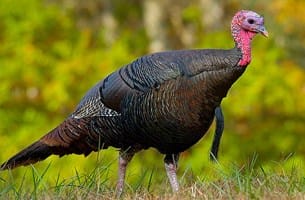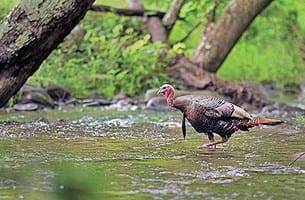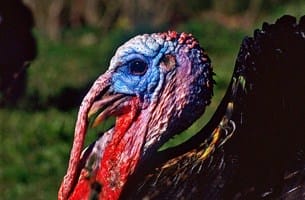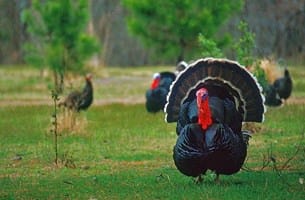Article provided by Game & Fish

One of the great attractions of turkey hunting is that there are simply so many different scenarios where you can encounter gobblers. Unlike some forms of hunting, there is no standard, sure-fire tactic that will guarantee success.
But despite their unpredictability, which is what many diehard turkey hunters enjoy, there are some patterns in their behaviour. Hunters with basic game plans and strategies for a number of different hunting scenarios have a better chance to harvest gobblers, regardless of where you hunt.
We’re going to explore a few scenarios where you can plot your strategy and have a better chance of seeing and harvesting that wily longbeard. As is the case in turkey hunting, you can expect that you may have to make last minute, even last-second, adjustments to ensure your game plan is on target where you hunt.
OPEN FIELDS
Without a doubt, this is one of the more difficult scenarios to successfully hunt, especially if the gobbler is already in the field when you get there.
Let’s figure the worst: he’s already in the field and he’s with hens. For many experienced gobbler chasers, it doesn’t get much worse than this. For the sake of reality, we’re going to figure that you do not have grass high enough or any cover such as low spot where you can crawl and sneak into shotgun range or even cut the distance substantially.
Generally the birds, the gobbler and hens, will be moving in a basic direction. My strategy is to ascertain that general direction. Then, I will back out of the viewing position I’m in, get good cover between me and those birds and high-tail it toward their anticipated exit area. If the field is rectangular or square, they tend to migrate toward corners. If the field is an odd shape, but has an indentation cove or a protruding point, that’s a high percentage target.
When approaching the open field for the setup, I use all the cover available and employ as much stealth as possible. I try to ensure that this spot is within the range of my gun to the edge of the field; hopefully, close enough to shoot 15 to 20 yards into the field if necessary. The contour of the land and density of cover will dictate that on a case-by-case basis.
This is simply basic turkey strategy. It’s always easier to harvest a gobbler if you’re between where he is and where he wants to go. If he doesn’t have to go well out of his way, then you may have a shot… literally.
For most of us, the calling is the essence of the sport, and I will call. I prefer to use a couple of soft, subtle calls. Contented, feeding purrs and clucks is all I do to begin. Often, the old longbeard will meander out of his way to look for the hen he hears. That’s where being close to the edge is close enough. He may not come into the woods, but he likely will come to the edge for a look.
The other choice, which sometimes will be made for you, is to engage a hen in a calling battle. Sometimes a boss hen will not just let a gobbler meander to another hen and she will cutt at the offending hen (you). If she does respond, give her back exactly what she gave to you, except perhaps a bit more emphatic. If she responds in kind, there’s a very good chance she will come into the woods looking for a fight and the gobbler will be in tow. You are now the hunted and the use of a mouth call is a very valuable tool to have available to all but eliminate moment on your part. Focus on the gobbler and have a spot pre-selected that you can shoot to with a killing shot with your gun. As soon as that gobbler gets within range, take him.
MID-MORNING

There’s a period of time I call the dead zone when early morning gobbling slows or ceases and things come to a standstill, or so it seems. Usually it occurs mid-morning and many hunters leave the woods figuring the best hunting is over.
Nothing could be further from the truth. The mid-to-late-morning hunting can be among the most productive of the day. When you get right down to it, when you elicit a gobble from a longbeard during mid-day, your odds of luring him into shooting range are much higher. Here’s what to do: Try walking and calling to locate a gobbler, also known as the cut and run strategy.
The strategy is simple. You move quickly from one good listening point to another, staying only long enough to make a couple series of loud, sometime raucous calls as you attempt to elicit a response from a gobbler. It doesn’t matter if the response is a shock gobble or a “come hither” gobble – the key is to get a bird located.
The basic concept behind this approach is that there are gobblers willing to work to turkey calls if you can locate them. That’s where the walk and call method works so well. It allows me to cover a large amount of territory in a very effective manner. And during the mid-morning, you may have to cover some ground to find a cooperative gobbler.
When walking and calling, you’ll likely want to call from every 200-to-300 yards. A hunter can quickly and effectively cover several hundred acres within a relatively short time doing this.
There are several factors which you should consider to maximize your efforts. It’s crucial that you make your calls from areas which gobblers frequent and that you do so from a place where your calls can be heard, and you can hear any response, at long distances.
Good examples are ridgetops, edges of cutover areas, pastures or at the head of a forested hollow. Unique situations will occur in different areas. The key is to select the best spots for presentation of your “cutts” and to hear a gobblers’ response.
Prior to making any calls, look around the immediate area for a tree or other cover in case you encounter a red-hot, here-I-come-on-the-run gobbler. I’ve enjoyed several situations where from the first call to a dead gobbler – or blown opportunity – happened within a couple of minutes. Once a bird gobbles, proper setup is another key to success.
The specific calling techniques employed are usually loud, aggressive ones. Remember, you’re trying to elicit a response from a bird that may be several hundred yards away. Once you get a response and set up on the bird, you may have to resort to more traditional calling to lure him in close. But until he’s located, rely on loud calls. I specifically like the tube, mouth, slate and box calls, as each of these can produce high volume and high pitched sounds. However, the push-pull calls sometimes work extremely well and if you can use the wingbone, this is an ideal situation for its use.
FOOD PLOTS AND FEEDING AREAS

This is where a hunter can literally take the game to the turkey. When hunting prepared food plots or areas of intense natural forage, you have something the gobbler wants: grub. If you set it up right, using food as a tool to lure a turkey to you can be one of the most productive tactics at your disposal.
This is a classic case of being at a place where a gobbler is eventually going to go. You just need to get there first.
The prepared food plot can take many forms from man-made food plots or agricultural fields to natural open areas with native plants and insects that turkeys like; any of these sources will attract turkeys.
Even a wooded area rich in turkey food will work. This tactic may require a bit more patience than many others, but it will produce turkeys.
A favored tactic is to set up a small blind that affords good visibility. If you are without a tent, just set up on a big tree and blend in as much as possible. Then sit and call intermittently.
One of my favorite tactics is to use two calls at the same time to imitate the sounds of multiple contented, feeding turkeys. Occasionally, a few loud yelps or cutts are thrown in to attract the attention of a distant bird. If that’s the case, as he approaches, he’ll pick up on the softer clucks, purrs and feeding turkey sounds.
If you heard turkeys gobbling in the area that morning but have lost track of them, this is a prime place to re-engage. Although you can’t rule out the possibility of a bird coming in gobbling every breath, much of the time, their approach in this situation will be sans gobbling. The gobbler may be totally silent or with only a few soft clucks being the only sounds made.
To make this tactic work, the burden is on the hunter to remain alert, quiet and still, except for the movements required for calling. You have to have the discipline to be ready for a bird you can’t hear. The ideal situation for me is to use a mouth diaphragm for one call and a push-button wooden call for the other. The only motion made will be by one finger of one hand that can be hidden by the blind or covered with a small piece of camo netting.
HUNTING ROOSTED BIRDS

The ideal method to hunt a turkey at dawn is to begin the evening before by roosting a gobbler. You need to be in the turkey woods before dark and if you don’t hear them fly up, you can use a crow call, or an owl call, to attempt to make one gobble with a loud noise (even a coyote call is effective) in hopes he will betray his position that evening. Then, the next morning you know where he’s at when you get to the woods. You then move in close before daylight to have good position without being spotted.
Be there well before first light the following morning.
Position is crucial as well. If you know the terrain and know which tree, or within a few yards of the exact tree in which the bird is roosted, you have some options. If there is a nearby open spot in the woods where it is easy and convenient for him to fly down, get within range of that spot. Make it as easy for him to fly directly out of the tree into gun range as you can.
Next, if the option is available, have the sun to your back and in his face. The tree you lean up against will hide you with shadows as the sun rises, and that same sun will illuminate him.
Listen for hen yelps. If you do not hear any in your area, be patient before making that first call. I personally like the gobbler to gobble once on his own, thus making the whole thing his idea. Then, an ever-so-faint tree yelp and a couple of clucks will likely have him gobbling the leaves off the trees. Unless challenged by other hens, keep your calls low and subtle. Odds are good he’ll pitch in your direction. If he isn’t within range when he lands, he’ll likely walk toward the source of the sound he heard. If you have some concealment as he moves, cluck or purr softly. If he is already coming your way, then doing nothing may be the absolute best call of all at that point.
Having a bird pitch down within gun range or win a few steps that he quickly covers doesn’t happen often. But I guarantee you it will make your entire season worthwhile when it does happen.
If the gobbler flies down and immediately is surrounded by hens, all is not lost, but you’re calling will probably need to be more aggressive. If he’s close to you, you can still coax him in. If the hens come to him, things get more complicated. I have called a gobbler in with hens in tow, but usually the hens will want to drag the gobbler away from you. Now would be good time to strike up a conversation with the boss hen and bring her to you, with the gobbler following.
If that doesn’t work but the gobbler stays in the area, then stay put. He knows you are there. After a period of time, if he’s breeding the other hens, he will finish and the hens will likely walk away. I generally make a call every 15-20 minutes in this scenario to ensure he’s still there and usually he’ll gobble back but not approach as long as he’s not yet done with the real hens he’s with.
Finally, however, (and this has occurred many times), he will cut my call off with an excited gobble and when I call back again immediately, he will not respond.
Slide your finger toward the safety and get ready… he’s coming.
This article was contributed by Game & Fish, a publication of Intermedia Outdoors. Visithttp://www.gameandfishmag.com/index.html for more useful hunting articles.



